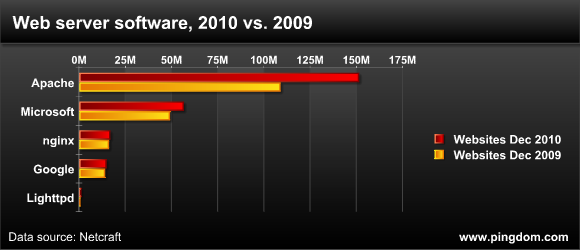 The World Wide Web would be nothing without web servers, and Apache has been king of that hill for a long time now. Although its market share has been slipping a bit in recent years, Apache came back with a vengeance in 2010.
The World Wide Web would be nothing without web servers, and Apache has been king of that hill for a long time now. Although its market share has been slipping a bit in recent years, Apache came back with a vengeance in 2010.
This became abundantly clear as we examined the growth of the top five web servers during the past year, from December 2009 to December 2010. As you’ll see, Apache really had a great year.
Web growth in 2010
Before we go into the details about each web server, here are some key numbers for how the Web changed in 2010, courtesy of Netcraft:
- By the end of 2010, the Internet had a total of 255 million websites.
- Compared to 2009, that’s an increase by 9%, or 21.4 million websites.
So basically, the Web keeps growing by leaps and bounds. It would have actually been a much higher number by 30 million or so if it weren’t for the fact that the Netcraft’s December 2009 number included the blogs from Tencent’s QQ, which are no longer included in the survey.
Web server growth in 2010
And now how web server usage changed in 2010:
- Apache went from hosting 109 million websites in 2009, to almost 152 million by the end of 2010.
- Net result: Almost 43 million new Apache websites in 2010.
- Microsoft IIS went from hosting 49 million websites in 2009, to almost 57 million by the end of 2010.
- Net result: Almost 8 million new IIS websites in 2010.
- Nginx failed to show the same explosive growth as it did in 2009, going from 16.2 to 16.9 million websites in 2010.
- Google’s web server (primarily for Blogger) went from 14.1 to 14.9 million websites in 2010.
- Lighttpd went from 840 thousand to 1.3 million websites.
Or better yet, let’s illustrate this with a chart:

You can clearly see how strong the past year has been for Apache. The number of Apache-hosted websites has grown by almost 40% in just one year.
Market share changes in 2010
To complement the numbers above, here is how the market share for each web server changed in 2010:
- Apache went from 46.6% to 59.4%, a massive gain of 12.8%.
- Microsoft IIS went from 21.0% to 22.2%, a 1.2% gain.
- Nginx went from 6.6% to 7.0%.
- Google’s web server went from 6.0% to 5.9%.
- Lighttpd went from 0.4% to 0.5%.
Just as the chart indicated, while the market share of IIS and nginx grew only moderately, Apache got a big boost.
Conclusion
This article shows that Apache is pulling away from its “arch enemy, ” Microsoft’s IIS. In December 2009 there were 2.2 times as many Apache websites as there were IIS websites. In December 2010 Apache had 2.7 times as many websites as IIS.
Apache is arguably one of the most emphatic open source successes, a product that has consistently since its birth been the preferred web server for millions upon millions of webmasters. Unless something drastic happens, it will remain dominant for a long time to come.
Data source: Netcraft



























